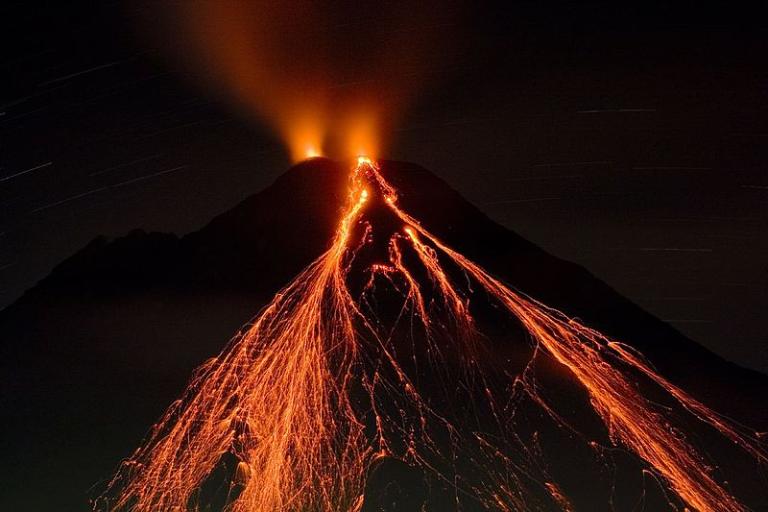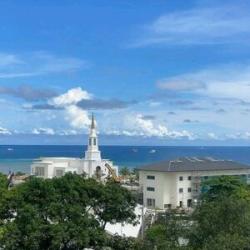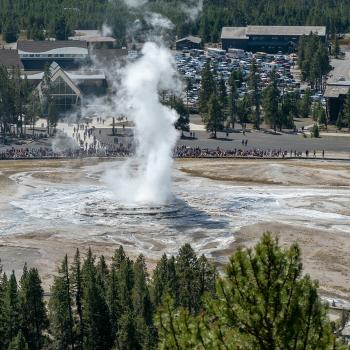
(Image from Matthew.Landry at English Wikipedia)
I’ve been sharing notes that I’ve largely drawn from an article written by a longtime friend of mine, Dr. Bart Kowallis, who is a Professor Emeritus in the Department of Geological Sciences at Brigham Young University, about the natural catastrophe described in the Book of Mormon as having occurred in the New World at the death of Christ: Bart J. Kowallis, “In the Thirty and Fourth Year: A Geologist’s View of the Great Destruction in 3 Nephi,” BYU Studies 37/3 (1997-1998):
Dan — In the Central American area and southern Mexico, there have been hundreds of volcanic eruptions, most of which have not been studied or dated in any detail. There is more data now than when I wrote that paper several years ago, but it is only a small sampling of all the eruptions that have occurred. Some devastating eruptions have been documented in some detail, such as the Ilopango eruption in about 500 AD that devastated the Mayan peoples living around that volcano. But many of the eruptions have not been studied, documented or even recognized. In the wet climate of this area, the ash from a volcano can alter from glassy particles to clay in a couple thousand years and these layers are often not recognized by archaeologists during excavations (although I believe that the more recent workers now pay more attention to them). So, the short answer is: no, I do not know of any particular eruption that can be pinpointed for the BofM story. But I do try to look at the literature on occasion to see if any new dates on eruptions have been documented. –Bart
***
In a follow-up email, Dr. Kowallis wrote:
I have attached an article that appeared in 2016. The article is not meant to document any particular eruption, but demonstrates the input of ash (now mostly altered to clay) in the Mayan lowlands and the importance of the ash for sustaining agriculture. The authors did obtain one radiocarbon date that falls in the range of Christ’s death (15-110 CE). Even though this is not a date on a particular volcano, it shows that volcanic ash was input into this area around that time. I have also attached Payson Sheets 2012 paper on the effects of volcanism on Central American cultures.
I did not feel it appropriate to pass either of the articles on here. In particular, as regards the paper by Payson Sheets, Professor Kowallis sent me a PDF of the entire book in which it’s included (Jago Cooper and Payson Sheets, eds. Surviving Sudden Environmental Change: Answers from Archaeology [Boulder: University Press of Colorado, 2012]), and I don’t believe that I have the right to share that book openly on a blog. But I do offer here the titles of the two specific articles, with their abstracts, for anybody who might be interested in pursuing the subject:
Kenneth Barnett Tankersley, Nicholas P. Dunning, Vernon Scarborough, Warren D. Huff, David L. Lentz, and Christopher Carr, “Catastrophic volcanism and its implication for agriculture in the Maya Lowlands,” Journal of Archaeological Science: Reports 5 (2016) 465–470.
Powder X-ray diffraction, high-magnification microscopy, and whole rock X-ray fluorescence spectrometry analyses of sediment samples collected from an ancient Maya reservoir at Tikal, Guatemala in 2009 demonstrated conclusively that volcanic ash was repeatedly deposited on the site. To test the hypothesis that volcanic ash was a major contributor of new parent material to soils in the southern Yucatan Peninsula we used these same techniques to analyze samples taken from several natural depressions (bajos) in the region. Our findings clearly indicate that volcanic ash is a major constituent of regional soils. Hence, explosive volcanism was a critical factor in the development and maintenance of ancient Maya urban centers by renewing agricultural soils. These centers were typically low-density “garden cities” largely dependent on their immediate environs for agricultural production. For these cities to flourish in a difficult environment a flux of volcanic material occurring within an optimal window was critical. Regional wind patterns and rainfall are seasonal, linked to the annual shift in the Intertropical Convergence Zone (ITCZ). During the wet season, the ITCZ sits over the Yucatan Peninsula with Trade Winds and Easterly Waves predominating and blocking ash fall from reaching the Maya Lowlands from the volcanic arc to the south. During the dry season, the southward shift of the ITCZ allows westerly and southerly winds to bring erupted ash over the region. However, ash fall occurring during the dry season also posed a risk for ancient Maya,who were dependent on capturing and storing rainwater to meet their water needs because of the problem of reservoir fouling. Intermittent periods of increased aridity amplified drought frequency and severity, which likely contributed to periods of disruption in the course of Maya prehistory.
“Responses to Explosive Volcanic Eruptions by Small to Complex Societies in Ancient Mexico and Central America”
Payson Sheets, University of Colorado, Boulder
The full range of societal complexities, from small egalitarian villages to state level civilizations, was impacted by explosive volcanic eruptions in ancient Central America and Mexico. Some societies were remarkably resilient and recovered from the volcanic disasters within decades. Others were vulnerable to sudden massive stresses and failed to recover. This chapter explores the factors that contribute to resilience or vulnerability, including societal complexity, demography and mobility, connectivity, magnitude of the eruption, social conflict, organization of the economy, loss of traditional environmental knowledge (TEK), and political organization. Each factor can be scaled regarding its contribution to vulnerability. As societies respond to disasters, not everyone suffers. There were winners and losers in the ancient past, as there are with contemporary disasters. People learn from disasters and modify their vulnerabilities. Therefore the creative aspects of hazard perception are also explored in this chapter.











